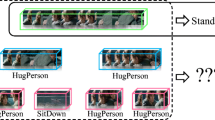Abstract
Human action recognition typically requires a large amount of training samples, which is often expensive and time-consuming to create. In this paper, we present a novel approach for enhancing human actions with a limited number of samples via structural average curves analysis. Our approach first learns average sequences from each pair of video samples for every action class and then gather them with original video samples together to form a new training set. Action modeling and recognition are proposed to be performed with the resulting new set. Our technique was evaluated on four benchmarking datasets. Our classification results are superior to those obtained with the original training sets, which suggests that the proposed method can potentially be integrated with other approaches to further improve their recognition performances.






Similar content being viewed by others
Notes
Here, one notes that the normalized warping path do not need to be equally spaced.
References
Mahbub, U., Imtiaz, H., Ahad, M.A.R.: Action recognition based on statistical analysis from clustered flow vectors. Signal Image Video Process. 8(2), 243–253 (2014)
Shao, L., Zhen, X., Tao, D., Li, X.: Spatio-temporal laplacian pyramid coding for action recognition. IEEE Trans. Cybern. 44(6), 817–827 (2014)
Pei, L., Ye, M., Zhao, X., Xiang, T., Li, T.: Learning spatio-temporal features for action recognition from the side of the video. Signal Image Video Process. 10, 199–206 (2016)
Keçeli, A.S., Kaya, A., Can, A.B.: Combining 2d and 3d deep models for action recognition with depth information. Signal Image Video Process. (2018). https://doi.org/10.1007/s11760-018-1271-3
Wang, L., Qiao, Y., Tang, X.: Action recognition with trajectory-pooled deep-convolutional descriptors. In: 2015 IEEE Conference on Computer Vision and Pattern Recognition (CVPR), pp. 4305–4314. IEEE (2015)
Chaaraoui, A.A., Padilla-Lpez, J.R., Climent-Prez, P., Flrez-Revuelta, F.: Evolutionary joint selection to improve human action recognition with rgb-d devices. Expert Syst. Appl. 41(3), 786–794 (2014)
Duan, L., Xu, D., Tsang, I.H., Luo, J.: Visual event recognition in videos by learning from web data. IEEE Trans. Pattern Anal. Mach. Intell. 34(9), 1667–1680 (2012)
Zhou, F., De la Torre, F.: Generalized time warping for multi-modal alignment of human motion. In: 2012 IEEE Conference on Computer Vision and Pattern Recognition (CVPR), pp. 1282–1289. IEEE (2012)
Guha, T., Ward, R.K.: Learning sparse representations for human action recognition. IEEE Trans. Pattern Anal. Mach. Intell. 34(8), 1576–1588 (2012)
Theodorakopoulos, I., Kastaniotis, D., Economou, G., Fotopoulos, S.: Pose-based human action recognition via sparse representation in dissimilarity space. J. Vis. Commun. Image Represent. 25(1), 12–23 (2014)
Zhang, D., Gatica-Perez, D., Bengio, S., McCowan, I.: Semi-supervised adapted hmms for unusual event detection. In: 2005 IEEE Computer Society Conference on Computer Vision and Pattern Recognition (CVPR), pp. 611–618. IEEE (2005)
Laptev, I., Marszalek, M., Schmid, C., Rozenfeld, B.: Learning realistic human actions from movies. In: 2008 IEEE Conference on Computer Vision and Pattern Recognition (CVPR), pp. 1–8. IEEE (2008)
Seo, H.J., Milanfar, P.: Action recognition from one example. IEEE Trans. Pattern Anal. Mach. Intell. 33(5), 867–882 (2011)
Rodriguez, M.D., Ahmed, J., Shah, M.: Action mach a spatio-temporal maximum average correlation height filter for action recognition. In: 2008 IEEE Conference on Computer Vision and Pattern Recognition (CVPR), pp. 1–8. IEEE (2008)
Neverova, N., Wolf, C., Taylor, G.W., Nebout, F.: Multi-scale deep learning for gesture detection and localization. In: Computer Vision-ECCV 2014 Workshops, pp. 474–490. Springer International Publishing (2014)
Schmid, M.F., Booth, C.R.: Methods for aligning and for averaging 3d volumes with missing data. J. Struct. Biol. 161(3), 243–248 (2008)
Demsar, J.: Statistical comparisons of classifiers over multiple data sets. J. Mach. Learn. Res. 7, 1–30 (2006)
Amit, K., Kaustubh, K., Srikanth, C.V.: Ramasubramanian: Towards fast, view-invariant human action recognition. In: 2008 IEEE Computer Society Conference on Computer Vision and Pattern Recognition Workshops (CVPRW), pp. 1–8. IEEE (2008)
Ahmadi, S.A., Sielhorst, T., Stauder, R., Horn, M., Feussner, H., Navab, N.: Recovery of surgical workflow without explicit models. In: International Conference on Medical Image Computing and Computer-Assisted Intervention (MICCAI), pp. 420–428. Springer, Berlin (2006)
Boudaoud, S., Rix, H., Meste, O.: Core shape modelling of a set of curves. Comput. Stat. Data Anal. 54(2), 308–325 (2010)
Morlini, I., Zani, S.: Estimation of the structural mean of a sample of curves by dynamic time warping. Data Analysis, Classification and the Forward Search, pp. 39–48. Springer, Berlin (2006)
Xie, X., De Vylder, J., Van Cauwelaert, D., Veelaert, P., Philips, W., Aghajan, H.: Average track estimation of moving objects using ransac and dtw. In: Proceedings of the International Conference on Distributed Smart Cameras, Article No. 28. ACM (2014)
Seltzer, M.L., Yu, D., Wang, Y.: An investigation of deep neural networks for noise robust speech recognition. In: 2013 IEEE International Conference on Acoustics, Speech and Signal Processing (ICASSP), pp. 7398–7402. IEEE (2013)
Liu, Y., Shriberg, E., Stolcke, A., Hillard, D., Ostendorf, M., Harper, M.: Enriching speech recognition with automatic detection of sentence boundaries and disfluencies. IEEE Trans. Audio Speech Lang. Process. 14(5), 1526–1540 (2006)
Chen, C., Jafari, R., Kehtarnavaz, N.: UTD-MHAD: a multimodal dataset for human action recognition utilizing a depth camera and a wearable inertial sensor. In: IEEE International Conference on Image Processing, pp. 168–172. IEEE (2015)
Lu, G., Kudo, M.: Learning action patterns in difference images for efficient action recognition. Neurocomputing 123, 328–336 (2014)
Jung, M., Hwang, J., Tani, J.: Multiple spatio-temporal scales neural network for contextual visual recognition of human actions. In: Joint IEEE International Conferences on Development and Learning and Epigenetic Robotics, pp. 235–241. IEEE (2014)
Acknowledgements
The work is supported by National Natural Science Foundation of China (61403232, 61327003), Natural Science Foundation of Shandong Province, China (ZR2014FQ025), and Young Scholars Program of Shandong University (YSPSDU, 2015WLJH30).
Author information
Authors and Affiliations
Corresponding author
Rights and permissions
About this article
Cite this article
Zeng, S., Lu, G. & Yan, P. Enhancing human action recognition via structural average curves analysis. SIViP 12, 1551–1558 (2018). https://doi.org/10.1007/s11760-018-1311-z
Received:
Revised:
Accepted:
Published:
Issue Date:
DOI: https://doi.org/10.1007/s11760-018-1311-z




